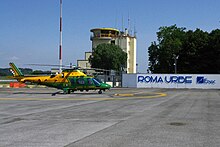Rome-Urbe Airport
| Rome-Urbe Airport | |
|---|---|

|
|
| Characteristics | |
| ICAO code | LIRU |
| Coordinates | |
| Height above MSL | 17 m (56 ft ) |
| Transport links | |
| Distance from the city center | 6 km north of Rome |
| Street | SS 4 (Via Salaria) |
| train | Nuovo Salario Station |
| Local transport | S-Bahn FR1 |
| Basic data | |
| opening | 1928 |
| operator | ENAC |
| Terminals | 1 |
| Start-and runway | |
| 16/34 | 1080 m × 30 m asphalt |
The Rome-Urbe airfield is a small airfield in the Italian capital north of Rome , where mainly general aviation is handled. The Rome Aeroclub has its seat at the airport . The Rome-Fiumicino and Rome-Ciampino airports serve the city of Rome as commercial airports.
Transport links
Via Salaria passes immediately to the east of the airfield . To the north it connects the airport with the A90 motorway ring and with the Autostrada del Sole , and to the south with the Roman city center. A railway line runs parallel to the Salaria. There is a train station near the airport ( Stazione Nuovo Salario ), from which the city center can be reached via the S-Bahn -like line FL-1 .
General aviation
In the general aviation sector, the airfield is mainly used by smaller propeller-driven aircraft, while business aircraft mainly fly to Ciampino. From the airport Urbe u. a. Sightseeing flights and air taxi services are offered. The airfield also serves as a heliport , u. a. for security and civil protection authorities.
history
The Rome-Urbe airfield ( Aeroporto del Littorio ) was inaugurated as a civil airfield in 1928. On a section of flowing past in the immediate vicinity Tiber also should seaplanes take off and land on water, but this project was never realized. In the 1930s, had the national airline of fascist Italy, the Ala Littoria , based here. From 1931 to 1934, the airfield was the racetrack Pista del Littorio on which, among other things 1932 the Motorcycle Championship was held.
During the Second World War , the airfield was used for military purposes. After the war, plans were made to develop Rome-Urbe into the central commercial airport of the Italian capital. However, the urban expansion of Rome to the north prevented any expansion options, which is why Rome-Ciampino Airport became Rome's international airport until the early 1960s. The Rome-Urbe airfield has been modernized in recent years and a heliport has been added.
Expansion plans
A second runway 1400 m long and 23 m wide (14/32) is planned in the area of the river arch. The aim is to open the airfield to machines the size of a Falcon 900 . With the current runway, the new runway would be V-shaped. To the west, along the Tiber, maintenance facilities are to be built, in the northeast new handling facilities.
More airfields
The Guidonia military airfield , located almost 30 kilometers northeast of Rome, has limited availability for general aviation. The former military airfield Rome-Centocelle , located between Ciampino and the city center , one of the oldest airfields in Italy (1909) and the former seat of the Roman aeroclub, has now largely been abandoned.
Web links
- Airport data on World Aero Data ( 2006 )
- Aeroclub di Roma (Italian)
